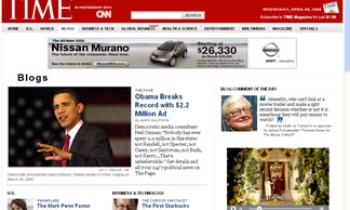In the next day or two, the world will get a glimpse of how desirable, or not, newspapers are, when preliminary bidding begins for Knight Ridder.
The fate of the company, the second-largest newspaper publisher in the United States in terms of circulation, behind Gannett, is being closely watched as a signpost for the future of other newspapers at a time of great transformation, anxiety and uncertainty within the industry. The newspaper industry is on the defensive, with circulation stagnant, advertising dollars migrating to the Internet and newsrooms reducing their work forces to save costs.
Given all that, it may be hard to believe that newspapers are actually profitable, but they are. And Knight Ridder is among the most profitable.
Of Knight Ridder's 32 daily newspapers, only four - one in San Jose, Calif.; one in St. Paul; and two in Philadelphia - have profit margins lower than 18 percent, according to an analysis by Morgan Stanley. Most of them are thriving. The Kansas City Star's estimated profit margin for this year is 24 percent. The Miami Herald's is 22 percent. The smaller papers averaged more than 26 percent.
The four less-profitable papers have specific problems peculiar to their markets. In San Jose, in the heart of Silicon Valley, The Mercury News is still trying to recover from the bursting of the tech bubble and the sharp loss of help-wanted ads that resulted. At its peak of profitability, in 1999-2000, the paper made more than $100 million. (Morgan Stanley estimates that it now has operating profit of $19 million to $20 million on revenue of $235 million.)
In Philadelphia, The Inquirer and The Daily News, an afternoon paper, have unions and high labor costs in a city with a still-lagging business climate, and they face strong competition from a ring of healthy suburban papers.
In St. Paul, The Pioneer Press is the smaller paper in direct competition with the aggressive Minneapolis Star Tribune in close geographic proximity.
And yet, even these papers are making profits. Their margins are just not as high as those in the rest of the chain. San Jose's margin, according to Morgan Stanley, is 8 percent; St. Paul's is 10 percent. Morgan Stanley said Philadelphia's margin is 9 percent, but company executives said it was somewhat higher, even with severance payments made this year.
Over all, Knight Ridder's profit margin in 2004 was 19.3 percent, about average for the industry. The average for Fortune 500 companies was about half that. But newspapers have traditionally had high margins, and so investors expect higher margins, said Conrad Fink, who teaches newspaper management at the University of Georgia. "The rising tide of shareholder expectation has reached unreasonable proportions," he said. "And the market is panicked about newspaper stock in an unreasonable way."
Professor Fink added: "There's a fear that this is a dying industry, when in fact it's an industry that has an unrivaled mandate, a franchise, in hundreds of cities across the country and in local news, and it has some of the strongest brand names in the country."
The potential sale of Knight Ridder was set in motion a month ago by the company's three largest shareholders, who perceived the company's stock as undervalued and demanded that the company be put up for sale.
Unlike many public newspaper companies, Knight Ridder has just one class of stock, so the founding families do not have a controlling interest that would allow them to block a takeover.
Knight Ridder quickly agreed to consult with Goldman Sachs and Morgan Stanley to explore its "strategic alternatives." As P. Anthony Ridder, the chairman and chief executive of Knight Ridder, said in a recent memo to his employees, the company is being singled out because Bruce S. Sherman, a founder of Private Capital Management, the largest shareholder, wants "to show strongly positive results" in his investment portfolios. His portfolio is heavy on newspapers, and Knight Ridder is the only one where his holdings have leverage.
Mr. Sherman has started a process that Mr. Ridder said had left his company in a state of uncertainty and has media insiders buzzing over possible outcomes.
The Morgan Stanley analysis said that the reasons to buy the company were the ability to cut costs further and "gain a larger foothold in the online world," from which analysts expect strong revenue in the future.
Its digital operation, combined with its investment portfolio, is valued at more than $2 billion. In addition, the company owns one third of CareerBuilder.com, a large and successful online recruitment site.
But the risks are potentially as great. They include the inability of some of the biggest markets, like Philadelphia, to recover; a further slowdown in the company's growth because of continued migration of readers and advertisers to the Web; and the difficulty in cutting costs further because of union protections.
Many argue that the papers have already trimmed most of their fat.
"Publishers have been making their numbers, meeting their profit objectives, through cost-cutting rather than revenue growth," Professor Fink said. "There's very little fat left in most of these markets."
The bigger papers have done away with most of their prestigious foreign bureaus. A dozen years ago, The Philadelphia Inquirer had bureaus in Moscow, London, Rome, Jerusalem, South Africa, New Delhi and Berlin. Today, it has one correspondent in Jerusalem, having closed its only other bureau, in Rome, this month.
The Miami Herald had bureaus in Beijing, Berlin, Jerusalem, Rio de Janeiro and El Salvador (later moved to Nicaragua). Today, it has a correspondent based in Bogotá, and two based in Miami who cover Cuba and the Caribbean. Knight Ridder has correspondents in nine cities, including Baghdad, who serve all 32 papers.
Colby Atwood, vice president of Borrell Associates, a media research firm, said that what was happening to Knight Ridder was a symptom of any company in a maturing industry. He said he would not be surprised if another media company acquired it.
"When growth in revenue has flattened out, the best way to increase profits is to attack costs," he said. "By consolidating operations, you can reduce costs by spreading them out across more properties. That's generally what happens in a maturing industry, and this may be the beginning of more consolidation. We'll see more of this, in various forms. It's a normal thing."









